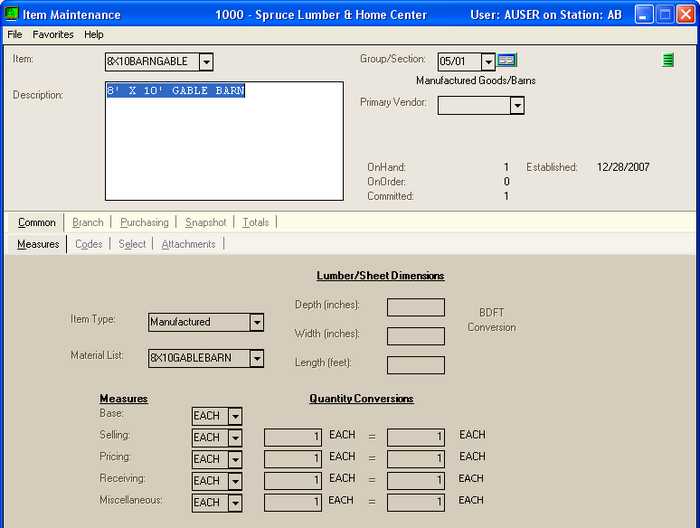Manufactured Items
A manufactured item type is the output product of manufacturing. Manufacturing involves removing "use" items (either from inventory and/or goods special ordered from a vendor), applying expense-type adjustments such as labor, etc. and finally resulting in some new product that can be sold. The end "product" of manufacturing is extremely flexible.
Manufacturing is processed from the Inventory application; however, it's necessary to set up one or more manufactured items in the Item database before getting to that point. Manufactured items may be either stocked or non-stocked; however, there are some functional differences between the two (discussed more below).
In addition, a "manufactured" type item may optionally be linked with a "material list." This list may contain "use" items, comments, prompts, and lists (of items, comments, and/or prompts) relevant to manufacturing. If no material list is used, the raw materials used for manufacturing will have to be entered manually each time the item is manufactured. Even if a material list is used, users can still add other items or make changes to the material list selections during the manufacturing process. Material lists on non-stocked manufactured items are also useful for option selection when creating an order from Point of Sale.

Stocked Manufactured Items
Stocked items can maintain an on-hand quantity and do not have to be linked with a customer order to be sold. If a material list is used with a stocked type manufactured item, all selection is done at time of manufacturing. Point of Sale transactions don't offer access to the material list options associated with the item. Typically, a "stocked" manufactured item is treated at point of sale like any other stocked item your company sells, you just happen to be the one responsible for manufacturing it.
Normally, this type of item would be best used when the output product is always the same or there's a limited number of variations being produced. There's really a large number of possible uses, but stocked manufacturing would likely be used for things like standard milling, treating lumber, picnic tables, small storage barns, fencing, etc. Basically, a company is most likely going to use stocked manufacturing for goods that they could purchase from a vendor for stock, but choose to produce themselves instead.
We should point out that a "stocked" manufactured product can have special order items associated with manufacturing. However, selection occurs during the manufacturing stage, not Point of Sale, so any non-stocked goods must be designated manually and not from a "materials list" that's associated with the manufactured SKU.
Non-stocked Manufactured Items
Non-stocked items need to be linked with a customer's order. Once the customer order is processed, the application creates a unique tracking SKU for each non-stocked manufactured item ordered. This item is not stocked but does maintain quantities for tracking purposes. Prior to processing and if the manufactured SKU is linked to a material list, the Point of Sale user is prompted to make selections in the material list and can also set pricing; however, the primary purpose of Point of Sale selection is not to determine an accurate price. Instead selection is more to allow the sales clerk to discuss and designate the options with the customer (really, any pricing prior to manufacturing is typically going to be an estimate -- price accuracy really depends on the type of item and options).
Associated material lists may have a set price or a variable price. In addition, the material list may contain stocked and non-stocked inventory (either or both). When non-stocked goods are involved in manufacturing, the Point of Sale user can set quantities and pricing on the special order goods in the material list. A separate tally of the special order price total is kept to assist the user in determining pricing. As in many cases, prices on special order goods, and the non-stock manufactured item, will vary.
Should an accurate price or better estimate be required, the manufacturing activity itself can be used because things like adjustments (labor, etc.) aren't applied until a work order is created in Manufacturing (under the Inventory area). Use the Build (F5) function under Manufacturing to link manufacturing processing with a customer's order in this case.
Adjustments and Staging
Adjustments, such as labor charges (for example), and staging (used to define steps in the manufacturing procedure) are not associated with a manufactured item directly. Instead, users may define a "manufacturing process" to create default entries for these functions (located under the database drop-down menu from the Inventory area). This "process" is used to define default adjustments (typically non-inventory expenses associated with manufacturing) as well as any steps or stages involved in the process. Staging is really just a way of breaking manufacturing down into steps, but it's not required. Stages must be advanced manually (there's no automatic timing).
If used, a manufacturing process is associated with a work order at time of manufacturing. The same work order can only be associated with a single manufacturing process although multiple manufactured items can be processed using the same work order.